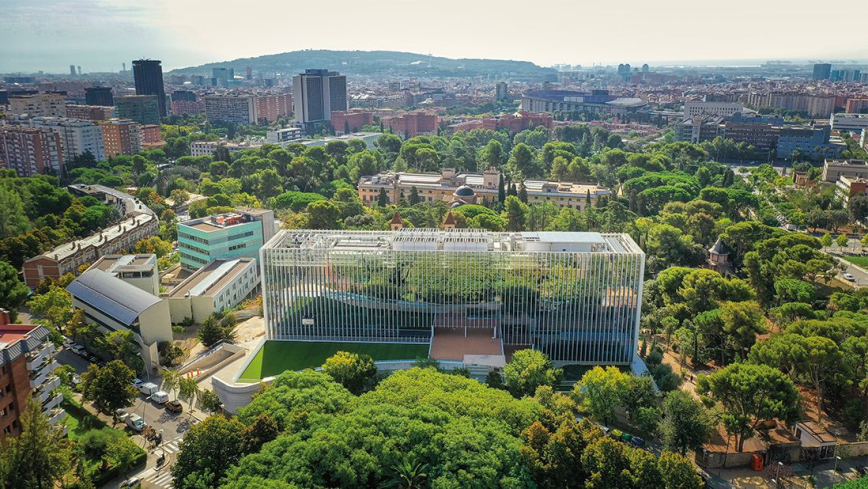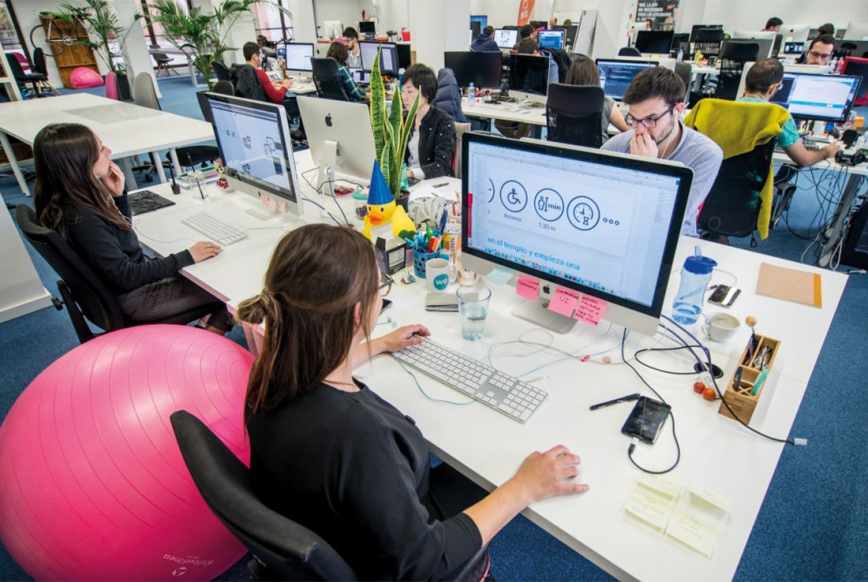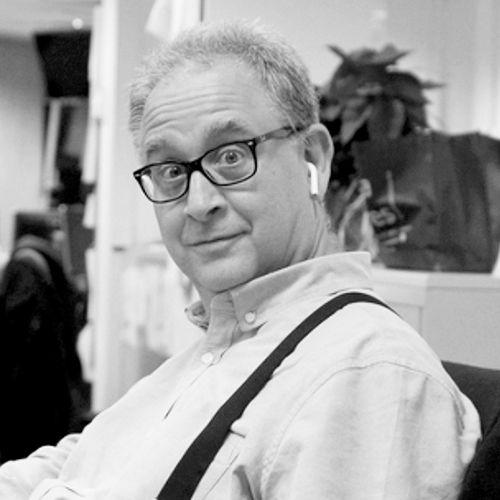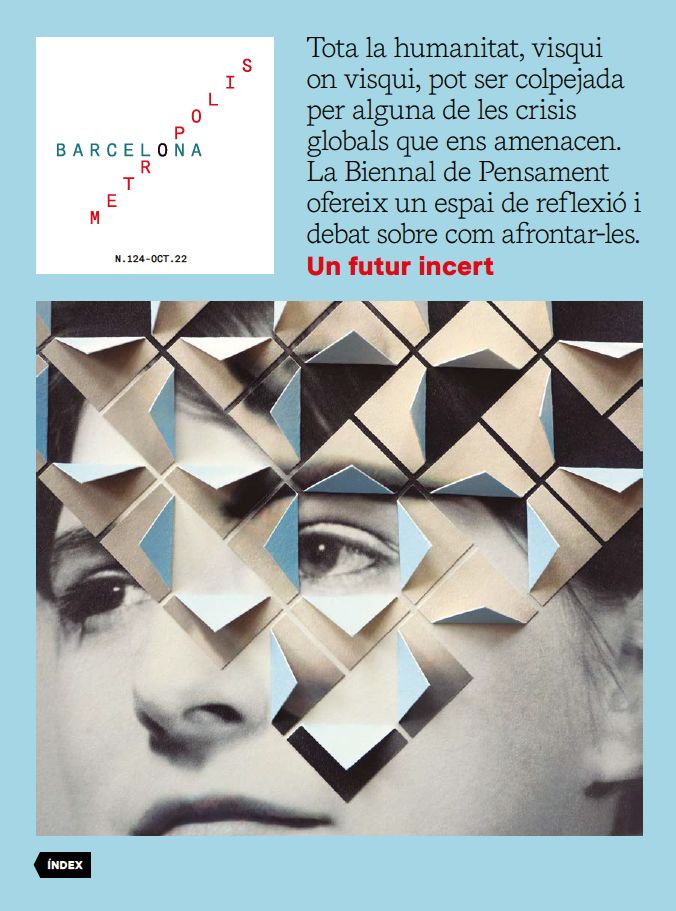Digital technologies, the new driving force behind Barcelona’s economy
- Urban visions
- Oct 22
- 14 mins

Thanks to the confirmation in July of the city as the permanent home of the Mobile World Congress, Barcelona is enhancing its appeal as a development hub for the technology sector, is attracting international meetings and congresses, is increasing its visibility everywhere, is boosting local technology companies and is benefitting economic sectors in the surrounding area. A strategy defined by the Mobile World Capital Barcelona Foundation (FMWCB) – a public-private entity – which is underpinned by four core goals for the future: transferring technology between academia and technology-based start-ups, fostering the creation of ICT-related jobs in Barcelona, rethinking the role of technology in society and making the Catalan capital a benchmark for technological humanism, and tracking the rollout of 5G technology.
Last June we woke up to the news that GSMA, the global telecommunications industry association, had agreed at its board meeting in Kuala Lumpur to extend the holding of the Mobile World Congress (MWC) in Barcelona for another six years, initially scheduled up to 2024. Therefore, one of the technology’s sector most important annual meetings on a global scale will remain in the Catalan capital until 2030 since its arrival in 2006 – when the major new development was the advent of 3G telephony – from a Cannes that had become too small for it.
It goes without saying that this new contract extension with Fira de Barcelona is very positive for the trade fair institution, whose primary source of income comes from the MWC editions, to the point that it justified the construction of the Gran Via venue in L’Hospitalet de Llobregat to host this and other large-scale events that could no longer be accommodated on the Montjuïc premises. It also proves beneficial for the local economic sectors (hotels, restaurants, taxis, nightlife, support services for stand construction and visitor services) that benefit every year from the presence, at the end of February, of tens of thousands of congress participants with high purchasing power: the 2019 edition, the last one before the Covid-19 pandemic saw a record 109,000 participants.
Furthermore, in more intangible terms, Barcelona also benefits from international visibility: it is no coincidence that, since the MWC has been held here, the city has hosted European and global meetings for numerous companies in the technology sector, with the participation of executives, customers, distribution channels, partners, developers and specialised media. HP Discover, Microsoft TechEd, Gartner IT Symposium/Xpo, Cisco Live, Citrix Synergy, VMware VMworld and many other conventions have been held here. This does not include other technology-related conferences, which will be mentioned later.
However, the MWC’s technological impact on the city and its sphere of influence goes beyond the duration of the congress, thanks to the fact that GSMA also named Barcelona the Mobile World Capital in 2011. This appointment is administered by the public-private foundation Mobile World Capital Barcelona (FMWCB), established in 2012. The foundation is chaired by the city’s mayor and, besides GSMA, Barcelona City Council, the Government of Catalonia and the Spanish Government are equal partners.
National 5G Observatory
FMWCB carries out its activities through four thematic programmes: The Collider, which promotes technology transfer between academia and technology-based start-ups, with a particular focus on new materials and grassroots research; Digital Talent, which fosters the creation of ICT-related, and therefore highly skilled, jobs in Barcelona; Digital Future Society, a think tank, a laboratory of ideas and reflection on the role of technology in our hyper-connected society, which aspires to make Barcelona a world benchmark for so-called “technological humanism”, with studies such as the one presented a few days ago on the risk of digital exclusion in urban areas; and, finally, Smart Connectivity, the programme in which the relationship with technology is most evident. On behalf of the Secretary of State for Telecommunications, it manages the National 5G Observatory initiative, which monitors the rollout of fifth-generation (5G) mobile telecommunications on a global scale and prepares reports that serve as a basis for state regulations on the subject.
 The new headquarters of the Barcelona Supercomputing Center is a 12,000-square-metre building, with four floors of offices, and will house the MareNostrum 5 supercomputer. © BSC / Barcelona City Council
The new headquarters of the Barcelona Supercomputing Center is a 12,000-square-metre building, with four floors of offices, and will house the MareNostrum 5 supercomputer. © BSC / Barcelona City CouncilBy the same token, through the 5G Barcelona initiative, FMWCB promotes the execution of 5G pilot tests with the participation of telephone operators, their equipment suppliers, technology centres and various companies and organisations, many of which are local. Thus, several places in Catalonia, especially Barcelona and its surrounding area, are or have been the setting of practical cases of 5G application in the automotive, industry, energy, healthcare, security, the rural environment and entertainment sectors. These applications range from the sensorisation of a nectarine farm in Albatàrrec (Lleida) to the creation at the Applus IDIADA technology centre in Santa Oliva (Tarragona) of the main installation in Europe for testing connected cars, as well as computer-based vision control of the approach of ships to the dock in the Port of Barcelona and the prevention of collisions between vehicles circulating in the Mercabarna area.
Barcelona and its surrounding area are or have been the setting of practical cases of 5G application in the automotive, industry, energy, healthcare, security, the rural environment and entertainment sectors.
The viability of 5G-guided remote surgery has also been verified, an ambulance for the Medical Emergency Service that allows doctors to receive detailed treatment instructions from specialists before arriving at the hospital, a remote support service for elderly people living alone, a virtual reality experience in which tourists have complementary information about unique buildings and shops on Passeig de Gràcia, and live 360-degree images from the stage of some concerts at the Cruïlla festival.
To make these tests possible, telephone operators have deployed specific 5G networks that, in many cases and upon completion of the project, have been permanently installed and made available to the public. One such example is the section of Ferrocarrils de la Generalitat de Catalunya (FGC) [Barcelona’s city and suburban rail network] between the Plaça Espanya and Europa-Fira stations that houses the 5G Railway Lab, one of the first railway facilities in the world with 5G coverage, which provides support for FGC telemetry applications, but also connectivity for passengers with a compatible phone.
Five hundred kilometres of fibre optics
These technological infrastructures created for the occasion add to the existing ones and those being deployed. Barcelona and its metropolitan area have fibre optic and mobile telephony networks with excellent levels of capillarity and coverage, thanks to the installation of short-range antennae in some street furniture, such as the traffic lights on Passeig de Gràcia.
In addition to private operator networks, there are more than 500 kilometres of fibre optics in the streets of Barcelona owned and managed by the city, as well as various complementary infrastructures based on connection modules via mobile telephone networks. The City Council’s corporate network has a redundant broadband infrastructure, with links of mostly one gigabit per second (Gbps), serving all municipal units. The public has access to the Barcelona Wi-Fi wireless network, which is public and free of charge, with thousands of access points inside municipal buildings, parks and gardens, metro stations and TMB buses.
A network of urban sensors is in place, linked to the open-source Sentilo platform, which the City Council created to collect, exploit and disseminate the information generated by the sensors and actuators distributed throughout the city.
A network of urban sensors is in place, linked to the open-source Sentilo platform, which the City Council created to collect, exploit and disseminate the information generated by the sensors and actuators distributed throughout the city. Among other actions, the platform is already used for monitoring the energy efficiency of municipal buildings, data collection on noise pollution levels and urban laboratory activities. As it is free software, any city can adopt it to interconnect its own devices and substantially reduce the cost of implementing smart city infrastructures. This is already being done by several municipalities in the territory, starting with Terrassa and Reus. Companies can also improve the platform, provide support or develop businesses based on Sentilo. Barcelona is also one of the leading urban environments for the multinational Cisco’s smart city platforms, which installed urban sensors (in lampposts and rubbish bins) in the Ribera district and has one of the world’s innovation hubs in this field in the former Ca l’Alier textile factory, which it is operating alone since Schneider Electric withdrew from the initial project.
Still in the area of network infrastructures, Barcelona’s connectivity with the rest of Catalonia is ensured by the Government of Catalonia’s Xarxa Oberta [Open Network], which links all the county capitals and numerous municipalities with fibre optics, both to provide service to official offices, schools and clinics and to promote the creation of local commercial telecommunications operators. Xarxa Oberta is currently operated by Cellnex. The Generalitat Government of Catalonia also operates the Anella Científica [Scientific Ring], which links the country’s main research centres with fibre optics.
International submarine cables
In terms of international connectivity, so far, two international submarine cables have been installed on the Barcelona coast, soon to be extended with the arrival of the 2Africa cable promoted by Meta Platforms (formerly Facebook) at the new landing station in Sant Adrià del Besòs. It originates from the south of England and crosses the Mediterranean after going around the African continent. Barcelona’s convenient location makes it a strategic one for data processing facilities. DE-CIX’s second data traffic exchange centre in Spain has been operating in the capital for a few months, and while the US giants of the Internet cloud chose to set up their large data centres elsewhere (Google, Microsoft, IBM and Oracle, in Madrid; Meta, in Toledo, and Amazon Web Services, in Huesca), other less popular digital companies, but of similar importance on the net, such as Interxion and EdgeConnect, are setting up in large data centres in Catalonia to take advantage of the availability of fast, high-capacity, low-latency international links.
Another type of infrastructure in which Barcelona is noteworthy is scientific and research infrastructure. These include the Computer Vision Centre at the Autonomous University of Barcelona (UAB), which is working on applying artificial intelligence to image recognition; the Institute of Photonic Sciences, which is essential for new computational models; the i2CAT Foundation, which is already working on 6G; the Alba Synchrotron, and the jewel in the crown, the National Supercomputing Centre on the campus of the Polytechnic University of Catalonia (UPC), which operates the MareNostrum 4 supercomputer mainly to solve climate models and biomedical problems. In addition, MareNostrum 5 (MN5), which will be incorporated into the EuroHPC network and which, with a power of 314 trillion operations per second, will be among the most powerful in the world, is already under construction. Besides increasing the capacity of its predecessor, MN5 will also work on designing supercomputing chips, with the participation of 300 researchers provided by the US firm Intel.
In addition, there is a network of technology centres that provide knowledge and development capabilities to the country’s SMEs. This is the case of Eurecat, which applies big data analysis in fields as diverse as tourism, food production and wastewater treatment (and each year organises a congress in Barcelona to disseminate advances in this discipline), but also Leitat, which manages the Dfactory L.4.0 robotics and 3D printing centre promoted by the Zona Franca Consortium of Barcelona on the site of the former Seat factory. Additive manufacturing, the formal name for 3D printing, already enjoys a certain tradition in Catalonia: the US firm HP has the world centre of excellence in this type of industrial machinery in Sant Cugat, which is revolutionising the kind of components that can be designed.
HP is one of the first ICT multinationals to set up here (initially to manufacture office inkjet printers) and has been attracted by the availability of skilled personnel. But it is not the only one. Other technology companies such as T-Systems, Vodafone, Alstom Wind, Mediapro, RTVE, Telefónica I+D, Indra and Dolby Labs are also based in Barcelona, mostly in the 22@ district, which was created 20 years ago. The latter, based on an audio innovation hub that emerged around the UPF’s Music Technology Group: the Dolby Atmos immersive sound system, which equips cinemas and provides consumer audiovisual equipment all over the world, was created in Barcelona. Until now, this segment had found its local meeting point in the Sónar+D congress as part of the Sónar music festival. Today it also includes the main international trade fair in the field, Integrated Systems Europe (ISE), which as of this year takes place at the Fira exhibition centre a few weeks before the MWC.
The Dolby Atmos immersive sound system, which equips cinemas and provides consumer audiovisual equipment all over the world, was created in Barcelona.
Global hubs for digital operations
In recent years, particularly since 2016, a large number of companies from various non-tech sectors have set up their global digital operations hubs in the Barcelona area. Examples include Nestlé, Lidl, Roche, Siemens, Axa, Zurich, Allianz, Amazon, Microsoft, Apple and Meta, which filter harmful content from their social networks from there. Moreover, Visa, Samsung, Global Payments, Arval and CaixaBank share in Barcelona an innovation hub in payment methods that develops applications such as payment in shops using facial recognition.
In parallel to the arrival of multinationals, Barcelona is one of the leading European capitals in the creation of technology-based start-ups, an ecosystem mainly structured around the Tech Barcelona association, which represents more than 1,200 companies (including start-ups and established companies), many of them housed in the two already consolidated general centres, Pier 01 (11,000 m2) and Pier 03 (3,000 m2) and others that will go to two new specialised centres, Pier 05 for financial technologies (fintech) and Pier 07 for health technologies (healthtech).
 The Tech Barcelona association, located at Pier 01, in Plaça de Pau Vila, hosts start-ups and innovation projects, especially those run by small companies. © Tech Barcelona
The Tech Barcelona association, located at Pier 01, in Plaça de Pau Vila, hosts start-ups and innovation projects, especially those run by small companies. © Tech BarcelonaThis entrepreneurial environment has given rise to several cases considered success stories at the time, such as Wallapop, Holaluz, Social Point, Softonic, Edreams and Scytl, as well as a powerful video game production subsector, which currently has 200 studios employing 4,000 workers and an annual turnover of more than 500 million, according to the Llibre blanc [White Paper] on the industry in Catalonia produced by the Department of Culture’s Directorate General for Innovation and Digital Culture.
Admittedly, the degree of genuine innovation in the start-up environment is extraordinarily variable, as there is an abundance of proposals that are simply replicas of successful business models in other countries or markets. There is also a certain lack of financial clout that really solid projects would need to make the big leap to the global market, due to the aversion of local capital to the risky investments that are so common in places like Silicon Valley. So much so that it is common here to boast about being a serial entrepreneur and many of the big operations that are proudly presented as success stories constitute foreign capital investments, which make the founders rich, but channel the potential profits to other countries.
Two local companies that are true powerhouses in their respective fields cannot be left out of this review of technological Barcelona. The first is Cellnex Telecom, Europe’s leading operator of neutral telecommunications infrastructures, which manages more than 130,000 mobile telephony sites in 12 countries, mostly acquired from the same operators who then rent them out on a shared-use basis. Cellnex, which also offers private networks for companies and operates networks for emergency and security services, was set up to run the state network of public radio and television repeaters, precisely the market in which the second company operates: Mediapro, which, in addition to producing audiovisual content and managing the broadcasting rights for major sporting events, has developed its own production and broadcasting technology, and has extended its scope to the field of digital entertainment (eSports) and the creation of virtual environments for training and marketing purposes, which can be framed within the budding concept of metaverses. These metaverses are also being explored by the Barcelona studio Glassworks VFX, which uses Microsoft HoloLens 2 augmented reality headsets to enhance the on-site visit to Antoni Gaudí’s modernista [Catalan Art Nouveau] building La Pedrera on Barcelona’s Passeig de Gràcia.
The newsletter
Subscribe to our newsletter to keep up to date with Barcelona Metròpolis' new developments




